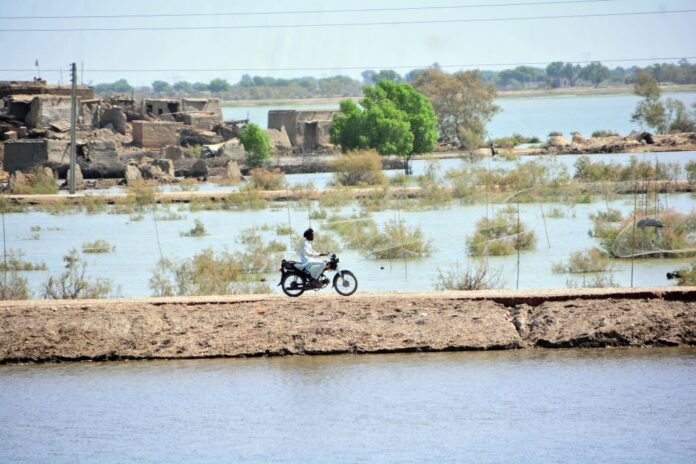— Manchar Lake cut displaced 100,000 people: minister’s estimate
— 128,000 pregnant women in need of care, 42,00 due by year-end
KARACHI: After the government in flood-hit Sindh breached the Manchhar Lake on Sunday to save densely populated areas from gathering flood water, levels in the nation’s largest freshwater lake and parts of the Dadu district were again on the rise on Monday as the authorities struggled to contain the devastating floods.
Record monsoon rains and melting glaciers in Pakistan’s northern mountains have brought floods that have affected 33 million people and killed at least 1,314, including 458 children, the National Disaster Management Agency (NDMA) said.
Manchar Lake, which is used for water storage, had already reached dangerous levels and the increased pressure posed a threat to surrounding areas in Sindh, Jam Khan Shoro, provincial minister for irrigation, said.
He said about 100,000 people would be affected by the breach but it would help save more populated clusters and also reduce water levels in other, harder-hit areas.
“By inflicting the breach we have tried to save Sehwan town. Water levels on Johi and Mehar towns in Dadu district would be reduced by this breach in the lake,” Shoro told Reuters.
On Monday, according to, Sher Mohammad Mallah, the official in charge of the irrigation cell for the lake, the water level in the body had risen to 125 reduced levels (RL) by afternoon, up from 123.2RL recorded Sunday night.
He told Dawn the lake’s protective dykes at RD 80, 75, 20 and 10 were “washed over” by waves and strong winds.
Meanwhile, Reuters reported it was not clear how many of the 100,000 asked to leave their homes would actually do so.
Some displaced by the floods have complained that shelters are crowded, while others are reluctant to leave their possessions.
HISTORIC RAINFALL
Aside from historic rainfall, southern cities of Pakistan have had to contend with increased flooding as a surge of water flowed down the Indus river.
The country has already received nearly three times the 30-year average rainfall in the quarter through August, totalling 390.7 millimetres (15.38 inches). Sindh province, with a population of 50 million, was hardest hit, getting 464 percent more rain than the 30-year average.
Being downstream on the Indus river, the southern parts of the country have witnessed swelling river waters flowing from the north. Pakistan’s limited dams and reservoirs are already overflowing and cannot be used to stop downstream flows.
Tarbela dam along the Indus River in Khyber Pakhtunkhwa, has been at capacity — 1,550 feet and 5.8 million acre-feet — for weeks, according to NDMA data.
Downstream in Sindh, barrages are under pressure with the Indus river in a high flood level, the NDMA said in its latest situation report.
Authorities also prepared for more rain in the north over the next few days up until Tuesday.
“Pakistan Meteorological Department (PMD) has forecasted that weak monsoon currents from the Arabian Sea are penetrating upper and central parts of the country which subsequently cause rain-wind/thundershowers,” the body said in an advisory.
It cautioned local administrations to be on an enhanced state of alertness, and to restrict vehicle movement in areas prone to flash floods and landslides as well as those close to water channels.
It said some populations in the north could be at risk, and advised “timely evacuation”.
‘MISERABLE LIFE’
Much of Sindh and parts of Balochistan have become a vast landscape of water, with displaced locals huddled miserably on elevated roads, rail tracks and other high ground.
Human and animal waste in the fetid water attracts swarms of flies, while outbreaks of dengue are being reported from mosquitos breeding in the swamplands.
One pregnant woman at a camp in Punjab said she was desperate for medical attention for a baby due any day now.
The mother-of-five knows it could be a difficult birth, as the baby has not shifted from the breech position.
“I need a doctor or a midwife. What if something happens to my child?” said Fahmidah Bibi.
The United Nations Population Fund said at the weekend there were at least 128,000 pregnant women in flood-hit areas who urgently need care — with 42,000 expected to give birth in the next three months.
Meanwhile, the overnight death toll from the floods increased by 25, of which 12 were children, according to an NDMA update. The United Nations children’s agency UNICEF said there was a risk of “many more” child deaths from disease after floods.
Prime Minister Shehbaz Sharif on Sunday appealed to UNICEF and other global agencies to help control child deaths.
“As Pakistan battles one of the worst climate-induced calamities, among the most adversely affected are children,” Sharif said on Twitter.
On Sunday, flights carrying aid from UNICEF, Qatar and the United Arab Emirates (UAE) landed in Pakistan.
— With Reuters, AFP























